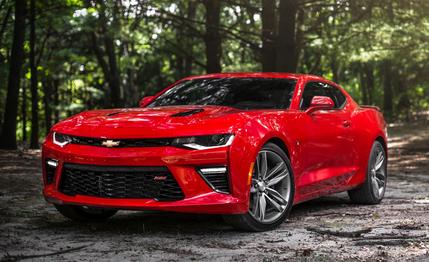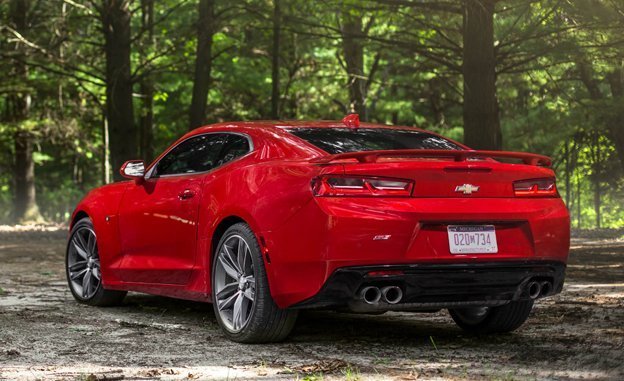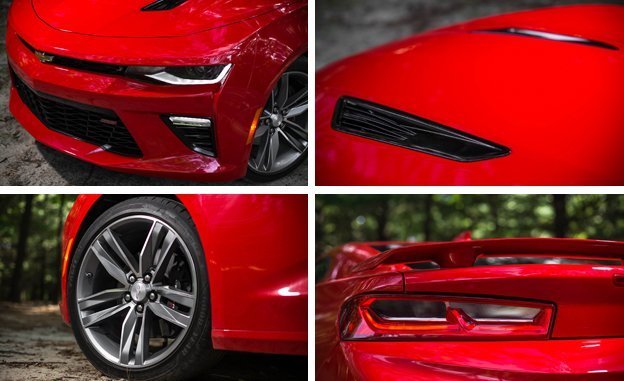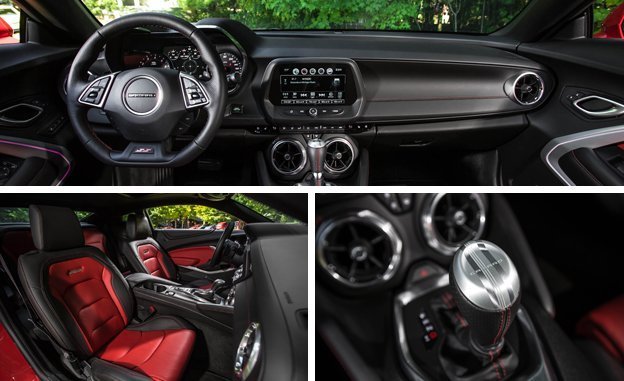 Instrumented Test
Instrumented Test
We’ll admit that when Chevrolet gave us a sneak peek at the 2016 Camaro a few months before the car’s unveiling, we were . . . well, we were disappointed. Oh, it’s a handsome enough thing, in a cartoonish, Transformers sort of way. But sitting there in a windowless room deep within the company’s Warren, Michigan, campus, the new Camaro’s stocky proportions, low roof, and squinting eyes made it look like a simple refresh of the then-current fifth-generation car that was parked next to it. It was the modernized 1969 Camaro again. Only this time a different anime artist drew the thing.
We asked a designer: What have you done to improve the outward visibility of this new car over the last one? He replied something along the lines of “Camaro owners haven’t told us that that was something they felt needed to be improved and they liked the styling of the car.”
Oh, dear. That did not bode well.
We knew that the new Camaro would be lighter than the old one, in part because it would ride on a version of the Alpha platform that serves Cadillac so well in the ATS and the CTS. And, of course, we knew that it would carry the Corvette Stingray’s brawny 6.2-liter LT1 small-block V-8 in SS versions. What we didn’t know during our early peep at the final design was how beautifully all of this componentry would work together to form such a kick-ass sports coupe. A sports coupe so ass-kickingly good, in fact, that the company could have bolted the body of the old Malibu Maxx to it and we’d still fight over the keys.

But we’re getting ahead of ourselves. That styling—with its narrow slits for side windows, fat C-pillar, and short rear glass—has, indeed, done nothing to improve the outward visibility in this new car. It is abysmal. We adjusted to it, partly by accelerating hard before performing lane changes just to clear some room. Adjust your mirrors carefully. The interior of the Ford Mustang feels ballroom-spacious by comparison.
The tanklike construction also prevents much light from entering the cabin, which, even with our test car’s bright-red upholstery accents, makes every drive in the Camaro feel like an adventure in spelunking. It’s not all bad news inside, though. The seats in our SS test car are simply fantastic—supportive and firm with just the right amount of bolstering. The steering wheel is perfectly contoured, as if our hands had formed it out of warm clay. The mix of interior materials, while not exactly Mercedes-level, are nonetheless a marked improvement on those of the old car. The infotainment screen’s surround and the instrument-binnacle trim are hard and chintzy, but who ever taps on those things, other than us?
Other ergonomic misfires include center HVAC vents mounted so low in the center stack that they dispense air directly onto your shifting hand, the world’s most useless door pockets, and an infotainment screen canted curiously down toward the floor, where it reflects the bright, faux-metal shifter surround. Thankfully, Chevy’s infotainment system is easy to navigate through the eight-inch touch screen. And our car came with interior accent lighting that can be changed to any of 24 different colors, six of which are some variety of pink. The rear seats? It’s best to not think of them as seats. As in the Porsche 911, they are simply upholstered shelves.
But enough of that. This isn’t a family sedan. This is a performance car and, hoo boy, what a performer it is. Our test car, an SS with the General’s new eight-speed automatic (a $1495 option), rocketed to 60 mph in 3.9 seconds, a noticeable half-second quicker than any current Mustang GT we’ve tested. It makes it through the quarter-mile in 12.3 seconds, close to a second quicker than the Mustang GT. At 455 horsepower and 455 lb-ft of torque, the Camaro SS’s 6.2-liter small-block produces 20 more horses and 55 lb-ft more thrust than does the GT’s 5.0-liter. The Chevy’s pushrod V-8 also makes great wads more grunt down low than the Ford’s overhead-cam engine.

Our loaded, $47,480 test car came with an optional dual-mode exhaust ($895), which does nothing at all to increase horsepower but makes the Camaro SS sound like it’s absolutely furious—spitting and barking mad. This is a welcome bit of antisocial behavior compared to the Mustang GT’s relatively demure-sounding engine. The Camaro’s engine is tuned to let out a brief bawl on full-throttle upshifts, which, it must be said, are exactly as firm as we’d like. The eight-speed automatic is a pretty spectacular piece of work, and that’s coming from the Save the Manuals people. It even responds quickly to paddle-activated manual shifts.
There have been plenty of quick and bawdy Camaros over the years, though. What’s a bit more unexpected this time around is the level of precision with which this Camaro moves. It helps that, at 3760 pounds, this new car is about 100 pounds more trim than a similarly equipped fifth-generation car. It’s a tidier package overall, losing a couple of inches of wheelbase and length and an inch of width compared with the outgoing car. The new Camaro also uses aluminum front-suspension links, and while the rear links are steel, they’re shot through with lightening holes. The Camaro’s structure doesn’t feel light, though; it feels as tank-solid as the tanklike visibility suggests it is. But the car moves in a way that belies that impression. Quick electric-assist steering and excellent front-end grip mean that you fire the Camaro into corners. There is no extraneous steering input necessary as the Camaro exhibits excellent path control. Body motions—roll, pitch, and squat—are all tightly controlled. What little body motion that is allowed is meted out in a perfectly progressive fashion. A trustier back-road companion is hard to come by. It’s not the muscle-bound brute some might be expecting and that its body might suggest—it’s a fully modern sports coupe.
A drive-mode selector tailors steering effort, damper stiffness, stability-control leniency, and transmission mapping to one of four settings: Touring, Sport, Track, and Weather. That we were perfectly happy to leave the thing set in Touring, even through demanding, twisty roads, speaks to the high level of designed-in performance. In fact, we liked the relatively light steering effort in Touring better than the heavier settings offered in the sportier modes.

Perhaps more remarkable: The Camaro’s impressive dynamic fidelity doesn’t render its ride uncomfortable. Even wearing low-profile run-flat tires (245/40ZR-20s in front and 275/35ZR-20s at the rear), the Camaro manages to chamfer off the edges of sharp road irregularities. Surely, our car’s optional, $1695 magnetorheological dampers aided in this feat. Those tires, Goodyear Eagle F1s, helped the car deliver an impressive 0.98 g of lateral grip on the skidpad. And allied with four-piston Brembo calipers front and rear, they also help deliver stops from 70 mph in a stunning 147 feet. That’s a shorter stop than we’ve recorded for at least a couple iterations of the current Porsche 911.
It all goes to prove that there is no shame in shopping in the corporate parts bin when that bin contains excellent parts. Thanks to those parts, especially the reworked Alpha platform, the sixth-generation Camaro is not only newer than it looks on the outside, it has attained a new level of driving precision for its genre. It turns out that the robo-1969 styling is there just to remind you that the Camaro is still in the pony-car class.